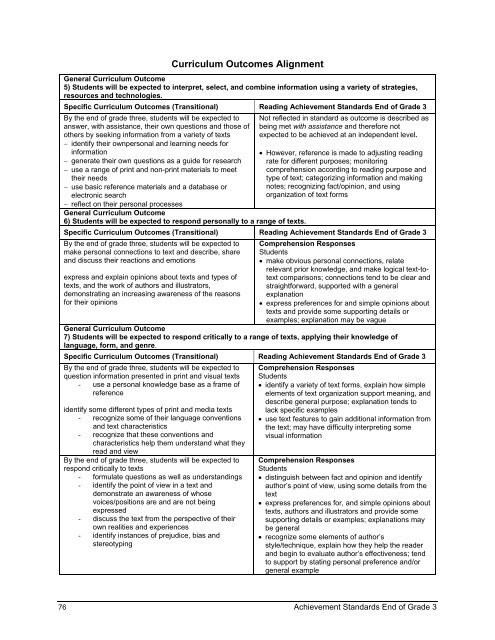Reading and Writing Achievement Standards Curriculum
Reading and Writing Achievement Standards Curriculum
Reading and Writing Achievement Standards Curriculum
Create successful ePaper yourself
Turn your PDF publications into a flip-book with our unique Google optimized e-Paper software.
<strong>Curriculum</strong> Outcomes Alignment<br />
General <strong>Curriculum</strong> Outcome<br />
5) Students will be expected to interpret, select, <strong>and</strong> combine information using a variety of strategies,<br />
resources <strong>and</strong> technologies.<br />
Specific <strong>Curriculum</strong> Outcomes (Transitional) <strong>Reading</strong> <strong>Achievement</strong> St<strong>and</strong>ards End of Grade 3<br />
By the end of grade three, students will be expected to<br />
answer, with assistance, their own questions <strong>and</strong> those of<br />
others by seeking information from a variety of texts<br />
− identify their ownpersonal <strong>and</strong> learning needs for<br />
information<br />
− generate their own questions as a guide for research<br />
− use a range of print <strong>and</strong> non-print materials to meet<br />
their needs<br />
− use basic reference materials <strong>and</strong> a database or<br />
electronic search<br />
− reflect on their personal processes<br />
General <strong>Curriculum</strong> Outcome<br />
6) Students will be expected to respond personally to a range of texts.<br />
Not reflected in st<strong>and</strong>ard as outcome is described as<br />
being met with assistance <strong>and</strong> therefore not<br />
expected to be achieved at an independent level.<br />
• However, reference is made to adjusting reading<br />
rate for different purposes; monitoring<br />
comprehension according to reading purpose <strong>and</strong><br />
type of text; categorizing information <strong>and</strong> making<br />
notes; recognizing fact/opinion, <strong>and</strong> using<br />
organization of text forms<br />
Specific <strong>Curriculum</strong> Outcomes (Transitional) <strong>Reading</strong> <strong>Achievement</strong> St<strong>and</strong>ards End of Grade 3<br />
By the end of grade three, students will be expected to<br />
make personal connections to text <strong>and</strong> describe, share<br />
<strong>and</strong> discuss their reactions <strong>and</strong> emotions<br />
express <strong>and</strong> explain opinions about texts <strong>and</strong> types of<br />
texts, <strong>and</strong> the work of authors <strong>and</strong> illustrators,<br />
demonstrating an increasing awareness of the reasons<br />
for their opinions<br />
Comprehension Responses<br />
Students<br />
• make obvious personal connections, relate<br />
relevant prior knowledge, <strong>and</strong> make logical text-totext<br />
comparisons; connections tend to be clear <strong>and</strong><br />
straightforward, supported with a general<br />
explanation<br />
• express preferences for <strong>and</strong> simple opinions about<br />
texts <strong>and</strong> provide some supporting details or<br />
examples; explanation may be vague<br />
General <strong>Curriculum</strong> Outcome<br />
7) Students will be expected to respond critically to a range of texts, applying their knowledge of<br />
language, form, <strong>and</strong> genre.<br />
Specific <strong>Curriculum</strong> Outcomes (Transitional) <strong>Reading</strong> <strong>Achievement</strong> St<strong>and</strong>ards End of Grade 3<br />
By the end of grade three, students will be expected to<br />
question information presented in print <strong>and</strong> visual texts<br />
- use a personal knowledge base as a frame of<br />
reference<br />
identify some different types of print <strong>and</strong> media texts<br />
- recognize some of their language conventions<br />
<strong>and</strong> text characteristics<br />
- recognize that these conventions <strong>and</strong><br />
characteristics help them underst<strong>and</strong> what they<br />
read <strong>and</strong> view<br />
By the end of grade three, students will be expected to<br />
respond critically to texts<br />
- formulate questions as well as underst<strong>and</strong>ings<br />
- identify the point of view in a text <strong>and</strong><br />
demonstrate an awareness of whose<br />
voices/positions are <strong>and</strong> are not being<br />
expressed<br />
- discuss the text from the perspective of their<br />
own realities <strong>and</strong> experiences<br />
- identify instances of prejudice, bias <strong>and</strong><br />
stereotyping<br />
Comprehension Responses<br />
Students<br />
• identify a variety of text forms, explain how simple<br />
elements of text organization support meaning, <strong>and</strong><br />
describe general purpose; explanation tends to<br />
lack specific examples<br />
• use text features to gain additional information from<br />
the text; may have difficulty interpreting some<br />
visual information<br />
Comprehension Responses<br />
Students<br />
• distinguish between fact <strong>and</strong> opinion <strong>and</strong> identify<br />
author’s point of view, using some details from the<br />
text<br />
• express preferences for, <strong>and</strong> simple opinions about<br />
texts, authors <strong>and</strong> illustrators <strong>and</strong> provide some<br />
supporting details or examples; explanations may<br />
be general<br />
• recognize some elements of author’s<br />
style/technique, explain how they help the reader<br />
<strong>and</strong> begin to evaluate author’s effectiveness; tend<br />
to support by stating personal preference <strong>and</strong>/or<br />
general example<br />
76 <strong>Achievement</strong> St<strong>and</strong>ards End of Grade 3
















